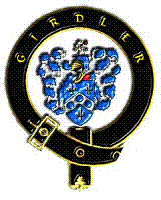 |
 |
 |
 |
 |
Girdler - Origin of the name:
The surname "Girdler" is English and is of occupational origin, meaning it is descriptive of the work or profession a person performed. In this case, the name was from the actual occupation of "Girdler" who was a maker of "Girdles", with the term girdle being descriptive of a belt worn round the waist or hips to secure or confine the garments. During some periods, the girdle was worn for a decorative costume effect. They were also employed as a means of carrying light articles, especially a weapon or purse. Of major use was the "Military Girdle" worn with suits of armor. Girdles were usually made of metal, leather, fabric or cord and were usually worn with one or two hanging ends. In the sixteenth century in particular, the lady's girdle hung down in the center front of the dress and terminated in a pomander, jewel, mirror or book. The early girdle term should not be confused with the later girdle term usage that is associated with the lightweight corset worn as an undergarment. The history of the girdle in England provides proof that it was in use there in very remote times as far back as the ancient Britons, being probably introduced to them by the Phoenicians. In some of the early British graves traces of girdles have been found.
"Hume" in his "History of England" thus describes the dress of the ancient Britons: "The Britons tattooed their bodies, staining them blue and green with woad as a sort of war paint. They wore checkered mantles like the Gaul, their waists were circled with a girdle, and a metal chain adorned the breast".
The general costume of the Anglo-Saxon period appears to have been quite simple. A plain tunic enveloped the body reaching to the knee. It was fastened round the waist by a girdle of folded cloth of the same color or secured by a band slightly ornamented.
In the time of the Normans the ordinary costume of the people was a tunic confined at the waist by a colored girdle. But the priests, not content with so simple a dress, went more elaborate with long gowns and golden girdles.
Later a law was passed which was directed against the prevailing extravagance in dress, and in particular aimed at reducing the splendor of the girdle, laying down restrictions that knights whose incomes was under a certain sum were not to have their girdles decorated with jewels and squires were not allowed to have any gold or silver decorations on theirs, still despite these restrictions , at no other time in history were the girdles so handsome or so costly as during that period. It is not uncommon to find mention of girdles in early wills being a bequest to a particular family member. The theft of girdles was a hanging offence under the harsh criminal laws that at one time prevailed in England.
The oldest mention of the girdle is in the old Assyrian Legend of Istar where the goddess of love refers to her many-gemmed girdle.
On the Nineveh sculptures the soldiers are represented with broad girdles to which the sword is attached, and through which two and three daggers are passed.
Ulysses prayed to his father, the god Poseidon, and called him "the Girdler of the earth".
In the Bible the girdle is constantly referred to. In Exodus the colors of the curious girdle of Aaron are given and it was numbered among the holy garments.
Some early English references to the girdle are; Seiohannes witodice haefde reaf of offence harum and fellenne gyrdel (year 1000). His girrdell wass off sherpess skinn (1200). In stude of is gurdel also; with rope he him bond (1290). By hire girdel heeng a purs of lether (1386). My girdyl of ledir barryd with siluir with bokyll and pendaunth (1463). Gyrdelles of chaynes of golde and syluer (1525). Behold the Girdle-Belt, with nails of burnishe'd gold (1697). The nobility, wear also a black girdle about four fingers broad and garnished with plates and buckles of silver (1756).
Early English findings of the "Girdler" trade are; "Girdillers Noble" year 1400. "Girdellers" formed part of the procession in York, England pageant in the year 1415, also found "Ye crafte of Girdelers in ye city of York" year 1428. "The wardens of fellowshippe of gyrdelers or any other of the kynges subjectes" year 1532. "They walked with the coverlet-weavers during the pageant at Norwich, England" year 1533. "They also walked with the card-makers and hatters at Chester, England", "Talke with a Girdler, or Milner" 1613. "The Kings Girdler" 1671. "Soward-Cutler and Girdler" 1723. "There are articles of work such as that of girdler, which is no longer a seperate trade" 1807. "The court of the Girdlers company dined at the hall" 1872.
These trade notations refer to the "Worshipful Company of Girdlers" formed in London, England with Arms granted in the year 1457. This craft company dates back into Anglo-Saxon times and the first recorded Master of the Girdler's Company was "Ralphe De la Barre" year 1180, the second was "Gerard the Girdler". Other Masters were "Benet le Sinturer" (Sheriff) 1216, "John de Prestone" (Mayor) 1334, "Sir Stephen Soames" (Lord Mayor) 1598.
A full descriptive history of the "Girdler" craft company can be found in the publication "An Historical Account of the Worshipful Company of Girdlers, London" by W. Domville Smythe, printed 1905. It states that formerly there were many terms to express a Girdler. according as you spoke in Anglo-Saxon, English, Norman-French, or Latin. the following are some examples, namely; gyrdyler, gurduler, girdeller, gerdler, seinter, seinturer, seingterer, ceynturer, ceinturer, zonar and other variations. With this in mind, notations can be found such as ; "Robert le Gerdler an inhabitant of the town of Berwick-on-Tweed, ad 1296", "William Brigerdler", "Thomas de la Cornere Seingterer", "Walter le Seinturer" and "Thomas le Seinturer".
The girdler craft was divided by various individual abilities. Some of the most notable were: "Girdlers Proper" -- These persons had the ability to make a complete girdle throughout. "Bandyleers" -- Made girdles for war service and the military. "Brigirdlers" or "Brace Girdlers" -- persons who made something somewhat like our modern braces as well as a form of arm-guard. This protective device was worn to protect the forearms against sword and knife wounds. The common soldier wore leather but officers wanting to be a standard above had theirs decorated with precious metals and jewels. This device was named "Brace" since it protected the brachium or forearm. This armband would become incorporated into decorative jewelry worn socially, especially by women. The woman's band was made smaller than the mans and would become known as a bracel-et or in our present language "bracelet". "Bokelers" -- Made buckles and "garetters" (garters).
The accompanying sketches of twelfth to sixteenth century styles give a clearer idea of what these girdles were like. They also show how they were fastened and provide examples of both male and female types worn both at the waist or hips. Please observe that the art of the girdler did not stop with a plain and simple belt, but it was in the "harnessing" and "garnishing" of the girdle that the skill of the artizan was shown. Indeed the workmanship was often of a very beautiful, elaborate and costly character, many of the girdles being ornamented with jewels or gold and silver worked up to a fine degree of finish so that the girdle was often a very expensive article, besides being exceedingly handsome.
 |
 |
 |
 |
 |
The occupational name "Girdler" is best described in modern terms as a maker of belts or waistbands. There have always been variations in family name spelling. From the old English or Anglo-Saxon it was "Gyrdel" followed by the business owners name, because it was occupationally derived. Also found is Girdlere, Gurdlere, Girdel, Girdle, Girdlyer, Gurler, Girder, Girdlar, Gerdlor, Girdley and Gorlor. The name of "Euerard Gurdel" is found in 1177, "Adam le Gurdlere" 1273, "Geoffrey le Gurdeler" 1275, "Luke le Gerdler" 1277, "William Gurdeler" 1279, "Henry le Girdlere" 1295, "Robert le Gerdler" 1296, "Ralph le Gurdelar" and "Robert le Girdlere" 1300, and "Henricus Girdelar" 1379.
On my last check of the LDS, micro-fiche, England, 1988 issue, I find 42 pages containing "Girdler" and other variations of that name.
Robert Joseph
Girdler. Lebanon, Ohio. USA.
Return to Girdler arms.